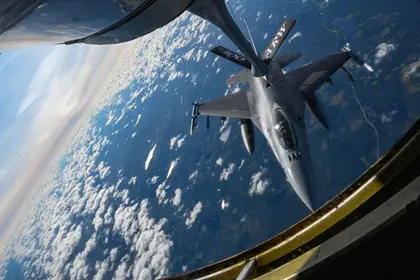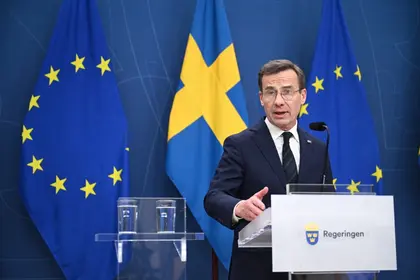NATO air forces have beefed up surveillance of the Atlantic Alliance’s southeastern frontier in recent weeks with the rare deployment of E-3A Sentry AWACS surveillance aircraft to airspace over eastern Romania.
The most recent sortie, on Wednesday, May 8, probably missed watching a major Russian missile strike on Ukraine in real-time by a matter of hours.
JOIN US ON TELEGRAM
Follow our coverage of the war on the @Kyivpost_official.
The first-ever flight by an E-3A Sentry AWACS into airspace over southern Romania since Russia invaded Ukraine in February 2022 took place on April 3, Kyiv Post research of open-source flight tracking platforms like FlightRadar showed.
Subsequent sorties were flown by the $227 million aircraft crammed with radar, listening, and communications gear into that airspace on May 2 and May 8, open-source data showed. According to NATO doctrine, the Sentry’s primary mission is to serve as a powerful “eyes in the sky” platform and airborne command post that monitors airspace to identify all aircraft, including both friendly and possibly hostile aircraft, and to enable efficient defenses and attacks by mission commanders flying NATO combat aircraft.


What Happened in Ukraine This Week? Test Your Knowledge
NATO flies E-3A Sentry surveillance missions almost daily, most often along Poland’s eastern border and over the Baltic states, and less frequently in eastern Scandinavia. Before April, the air battle command plane had not been spotted in Romanian airspace by open-source air traffic monitors.
On May 8 Russia launched a major missile and kamikaze drone strike against Ukraine, firing a mix of ballistic, “hypersonic” and cruise missiles totaling 59 weapons, and an additional 21 kamikaze drones, targeting energy infrastructure and civilian homes and businesses, official Ukrainian sources said.
That same day, according to flight tracking data some eight hours after the Russian missiles had struck or been shot down, a NATO E-3A Sentry flown by a Royal Netherlands Air Force crew appeared in airspace over Bulgaria, flew to eastern Romania and circled there for close to two hours, and then flew to Belgium.

It was not clear from data published by planefinder.net and other air traffic platforms where the AWACS with the call sign NATO11 took off from or how long it had been in the air before it became visible to civilian radars.
Had the NATO AWACS been in Western Black Sea airspace at the time of the Russian strikes – which seems possible but unlikely from the air traffic data – then the crew would almost certainly have been uniquely placed to observe the Russian strike in detail, monitoring every aircraft and missile in real-time.
The NATO decision to deploy – or if earlier flights had been surreptitious then to make visible to open sources – the alliance’s premier air battle intelligence and command planes in airspace over Romania, where the spy planes had not flown before, came against the background of major air defense exercises at the other end of alliance territory.
On Monday NATO kicked off a multi-national air defense exercise, called Astral Knight 2024, involving more than 50 aircraft and more than 5,000 service personnel from Lithuania, Poland, Britain and the US. The main objective of the two weeks’ training is to practice air defense coordination, aircraft and missile detection, and intercepts, and to deter aggression against NATO nations, a Brussels statement said.
“The US invested in advanced sensors, radars, and surveillance technologies, and integrated them with Allies and partners to develop a comprehensive and accurate common situational awareness picture. Such capabilities allow for effective detection, tracking and identification of potentially hostile airborne and missile threats,” the statement said in part.

The Polish General Staff in a May 8 statement said “a key role” in the integration training was being played by officers and soldiers from the regional air battle control units 83rd Air Operations Group (AOG) and the Air Operations Center. The exercises would develop cross-nation air combat coordination and strengthen interpersonal ties, the statement said.
In March, Poland’s Deputy Foreign Minister Andrzej Szejna told Polish radio station RMF FM that NATO along with Poland was considering using the alliance air defense systems to intercept Russian missiles aimed at Ukraine. Kyiv officials said they would welcome the help but officially neither Warsaw nor Brussels have endorsed the idea.
Russia on Monday announced the start of drills of its own to practice the use of tactical nuclear weapons and, separately, training for mass launches by non-nuclear missiles fired from Russia’s southwestern regions. Kremlin “news” platforms said the Astral Knight exercises were provocative and evidence of unjustified Western hostility towards Russia. The Sputnik news agency called the NATO training “saber-rattling.”
The milblogger Starshe Eddy, a vehemently pro-Russia platform, according to reports operated by the Russian media manager German Kulikovsky, in a May 8 write-up on the Astral Knight exercises said that NATO intends to prepare for an air war against Russia in a battlespace stretching from Turkey to northern Norway, with intervention against Russia already a reality for alliance planners.

“As I have said before, the NATO Air Force is the only force, the use of which could really, seriously change the course of hostilities for the Ukrainian (fight against Russia). For the moment, however, NATO is limiting itself to the territories of its own countries. At the same time, the topic of air defense/missile defense is becoming one of the main ones, showing that a possible clash with Russia is indeed viewed as an urgent threat,” Kulikovsky wrote.
You can also highlight the text and press Ctrl + Enter






